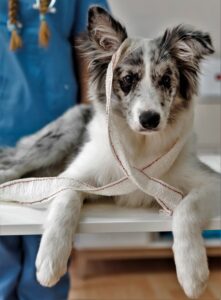
Vet bills settled up and now the healing journey is in your hands. A vet nurse’s advice can help you to manage your pet’s wounds successfully after surgery.
Skin repair: patience and good sense
Skin and soft tissue damage may be one of the most common reasons for a visit to the vet.
Aftercare and healing can sometimes be daunting for pet owners, but with insightful care, the journey can be a success. Let’s look at how you can manage wounds and restore your pet’s skin to a healthy protective layer.
Skin—a multi-layered approach
The skin is considered the largest organ of the body. It’s truly a magnificent organ with a myriad properties: a barrier against infection, chemicals and UV radiation, a Vitamin D and pheromone factory, a temperature regulator which also prevents loss of moisture, protein and electrolytes. It also has sensory properties which react to touch, temperature and pressure. It’s flexible too, and has an incredible ability to self-heal.
But once damaged, skin requires careful management to repair itself correctly. Careless treatment of wounds can mean disfigurement and further infection for your furry friend.
If skin is to heal successfully, it makes sense that we first need to understand its varying layers.
Epidermis: This resilient, shield-like outer layer comprises different types of cells. Some give rise to skin colour and others form part of the immune system. New skin cells are continually manufactured near the base of the epidermis, pushing dead cells to the surface to be shed.
The surface cells contain a protective protein called keratin which enables this layer to protect the body against water and electrolyte loss and invasion by microbes.
Dermis: A thin membrane attaches the epidermis to the middle layer or dermis. This is where the skin’s blood supply and nutrients come from. Nerves, muscles, hair follicles, lymph vessels, immune system cells, oil (sebaceous) and sweat glands also occur in this layer.
TOP TIP: The epidermis is about one-half to one-third as thick as the dermis (depending on the area of the body). A superficial wound involves only the epidermis and so will not bleed.
However, wounds that penetrate the dermis will bleed.
Hypodermis: Although not considered part of the skin, it is important to identify this layer when it comes to wounds. It is a fatty layer that connects the skin to the underlying muscles and provides insulation, fluids and electrolytes. It also acts as a shock absorber.
Types of damage
Generally, wounds can be classified according to how dirty they are. A clean wound, for example, is one that a surgeon makes in a sterile operating theatre. It is stitched and usually heals without further infection (primary intention healing). A contaminated wound is considered to be relatively new (imagine a dog that has cut itself on a fence and is taken directly to the vet). An infected wound is usually older than the first two and has been open for long enough to become infected. An infected wound may have to be left to heal on its own (called secondary intention healing).
Here’s the tricky part though—not all wounds can simply be closed with stitches (oh, if only!).
Sometimes, a bite wound or a road traffic accident results in massive skin trauma. This leads to insufficient healthy skin available to close a wound with sutures. Also, if a wound is infected, it can’t be stitched until the infection is halted. Stitching an infected wound is counterproductive; it merely provides bacteria with a great hidey-hole to multiply and prevent healing.
Some wounds are superficial and may only need to be cleaned and bandaged. There are also cases where wounds are complex and need to be stitched in stages or even assisted with a skin graft. As you can see, each wound must be evaluated and treated according to several different criteria. But one of the most crucial factors for successful healing is the absence of infection.
Stages of healing
For the purposes of this article, let’s discuss secondary intention healing as it’s more complicated than clean, stitched wounds.
Stage 1 – Stop the bleeding!
Firstly, the body tries to stop bleeding by reducing the size of the blood vessels and gathering platelets to clot and seal the area. A bleeding wound requires gentle pressure with a clean cloth. Bleeding that won’t stop is an emergency—get to the vet immediately.
TOP TIP: If your pet is wounded, the sooner bacterial contamination can be removed, the faster the wound will heal. When you can’t get to a vet immediately, the most effective rinse is a warm salt solution. Physical removal of dirt is the key. Do not attempt to kill bacteria with harsh chemicals inside a wound (do not reach for the Dettol!). These can often cause additional trauma instead of helping.
Four teaspoons of salt in a litre of clean, warm water (boiled and cooled is best) makes a solution similar to tears. If the wound has visible dirt, it must be rinsed repeatedly with this solution until it is completely clean—even a fresh wound, with no visible dirt must be cleaned the same way. This concentration of salt will neither dehydrate nor cause cells to swell.
Stage 2 – Inflammation
It may sound like a bad word, but inflammation is the body’s way of isolating the problem and summoning the task force. Blood vessels increase in size so white blood and other types of cells can get to work killing bacteria. The negative effects of inflammation are swelling, heat, pain and loss of mobility. It is normal: the body is trying to keep the area still and do its job. Remember the salt wash? This explains why the solution doesn’t add to the already painful swelling of the tissue.
Stage 3 – Debridement
The task force has a cleaning squad that essentially devours dead tissue. Pus (dead cells and bacteria) results from all the hard work. So even though it’s yuk, pus is a sign that the body is doing a good job. Sometimes, dead tissue can be too much for the body to deal with and the vet may need to cut it away.
Stage 4 – Repair
The repair stage causes the most headaches. It’s a long process that sometimes doesn’t seem to progress—hang in there. If, however, the wound has not passed stage 3 and is still infected, the repair will be hindered or even impossible. Your vet may even prescribe antibiotics to prevent a backward slide in healing.
There are three aspects to the repair stage:
Granulation tissue
The body lays down a glistening, delicate, bumpy matrix of blood vessels and cells—all with specialised skills. Your vet and/or vet nurse may decide to bandage the wound to keep it moist and clean at this stage of healing. However, bandaging has both positive and negative aspects.
Firstly, regular visits to the vet for bandage changes can be expensive and constantly interfering with the wound can break down delicate tissue.
Also, bandages create a moist environment necessary for the wound to heal, but if left on too long, they also create the perfect conditions for bacteria to multiply.
Bandages that are too tight can exclude blood flow, thereby starving the wound of precious oxygen and nutrients that are crucial for tissue healing.
TOP TIP: Vet nurses are specifically trained in bandaging techniques. Specialised wound dressings prevent some of the issues above. Pet owners should always aim for professional bandaging. Attempts to bandage wounds at home could lead to complications that will eventually need to be rectified professionally.
Bandages may seem dirty and full of dead tissue after the first few changes, but again, hang in there! This is a natural process. As long as there is no infection (bad smells and pus are a sign), the journey is underway.
Contraction
Collagen in the granulation tissue starts to pull the wound edges together. The skin cells on the edge of the wound begin to grow towards each other until the whole wound is covered. At this point, bandaging may not be necessary but it is still vital to keep the wound clean.
Scar formation
The new skin cells form a thin scar that will thicken over time and become more flexible. It will continue to pull the edges together until the wound is completely covered.
TOP TIP: Hypochlorous acid is my new favourite thing when it comes to choosing a cleaning solution that is safe for open wounds. Surprisingly, it is manufactured by our pets (and our) cells to kill bacteria and is now available commercially, it is environmentally safe and can be used on any type of wound. It isn’t bleach or chlorine (no sodium molecule) and works wonders to keep a granulating wound clean and moist. Listen to this fantastic podcast about Hypochlorous acid if you want further information.
Bon voyage and smooth sailing!
So, now you know everything about what it takes to heal an open wound but, if it were all smooth sailing, there would be no need for this article. However, not all wounds heal according to the above process due to many reasons.
– Some wounds are just too big and when the body starts pulling edges together, they get infected or dry out.
– Often the wound is in an area that’s difficult to bandage and with constant interference, the healing process is impeded.
– Open wounds can get infected and start to smell. Flies are attracted to wounds and your pet may also want to lick them. All of this can lead to a breakdown in delicate tissue repair.
– Age, some types of medication and certain diseases can delay skin healing too.
– Deep wounds can be infected and in turn infect the whole system (septicaemia). This delays healing because the whole body needs to get rid of the infection before it can focus on the wound.
It is worth bearing in mind that managing an open wound cannot exist in a sterile bubble.
There will be challenges throughout the process and it may sometimes feel like a dark tunnel with no light. We have seen that the absence of infection and physical trauma and the presence of moisture are the keys to success. Add another key made from god-like patience and the door will eventually open.
I wish you success on your pet’s journey to healing!
© Liz Roodt 2023
